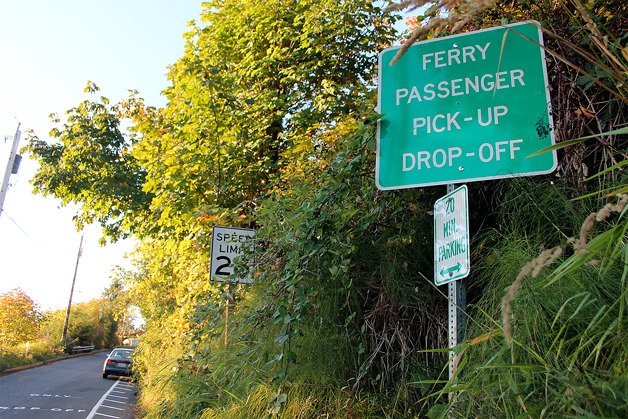Despite a handful of “for lease” signs that dot Highway 525, a group of a dozen people is vigorously working to spark growth in Clinton.
The Clinton Community Council, a non-elected volunteer group of people who banded together to give the sprawling, unincorporated area of Island County a voice, has several plans in the works to better define what Clinton will be in the next 20 years. Getting a better pick-up/drop-off area for the ferry terminal, crafting special design and land use rules for Clinton and a market analysis were all major topics for the council at its Monday night meeting.
Coming up Oct. 8 is a presentation and meeting with Island County planners about the comprehensive plan, a guiding document for growth, development and major projects that spans two decades.
There’s one glaring impediment for Clinton coming up with its own rules.
“There is no Clinton portion of the comprehensive plan,” said Jack Lynch, the community council president and a retired community planner.
The council’s hope is to essentially create a section for Clinton with development guidelines. Currently, design standards are uniform across rural areas of Island County, meaning standards in areas of North Whidbey, Central Whidbey, Camano Island and Clinton are all the same. What the community council wants to do, however, is emulate the success of the Camano Gateway Village Zone. Specially crafted zoning there allowed for commercial development along the state highway. The goal, said council member Doug Hofius, is to have design and development rules for Clinton’s commercial heart along the highway to be a little different from other rural areas.
The Island County Comprehensive Plan includes 10 elements about land use, water resources, shoreline, housing, historical preservation, natural lands, parks and recreation, transportation, utilities, and capital facilities. Given that the state and county are projecting a 2 percent population growth over 20 years, the county does not see any need to add or create a non-municipal urban growth area, similar to what Freeland has. Instead, the county and community council are interested in the benefits of a rural areas of intense development (RAID).
Without any projected rush of new residents, the concern for the council is how to improve and define what already exists for the future.
Hoping to add to that discussion is the Port of South Whidbey. Commissioner Curt Gordon, who is also the treasurer for the community council and a longtime Clinton resident, said the port had recently selected a firm to conduct a market study of Clinton. The yet to be signed $30,000 contract with the La Conner-based Beckwith Consulting Group will help the port, an economic development public agency, identify ways to improve commerce in the area.
“In the end, what I like is they want to create some actual targets to help out,” Gordon said.
He said he hopes to have the contract finalized in time to have the consultants attend the Oct. 8 comprehensive plan meeting to become familiar with the zoning and planning issues facing Clinton. The contract is for 14 weeks, Gordon said.
Potentially affecting more of the day-to-day life of Whidbey Island residents is the push by the council for improvements to the pick-up/drop-off area of the Clinton Ferry Terminal. A lingering problem, according to the council, is the use of Ferry Dock Road as long-term parking instead of the strict 15-minute designation posted by a few signs along the short stretch.
Money was included in the state transportation budget to address the issue, said council member Dave Hoogerwerf who also serves on the Island County Ferry Advisory Committee. The council wanted to make sure signs stating the area was for pick-up/drop-off only, by requiring drivers to remain with their vehicles, may allow for greater enforcement by the sheriff’s office and Washington State Patrol.
A lingering issue for the terminal, said Hoogerwerf, and one that he hopes is addressed sooner rather than later, is the construction of overhead pedestrian loading on the terminal. As the other side of the marine highway has construction begin on the new Mukilteo Ferry Terminal, including an overhead passenger loading span, Hoogerwerf said there’s no reason Clinton should not also be considered for one.
The Clinton Community Council generally meets the last Monday of each month to discuss things happening in the unincorporated area of Clinton, and is open to new members. Its next meeting will be with the Island County planning department about the comprehensive plan at 7 p.m. Thursday, Oct. 8 at Clinton Community Hall. This will be a chance to learn about what exists currently in terms of the 10 elements, and how to address some discrepancies and help craft how Clinton should develop in the next 20 years.



